|
| |
Back to Private
Aircraft
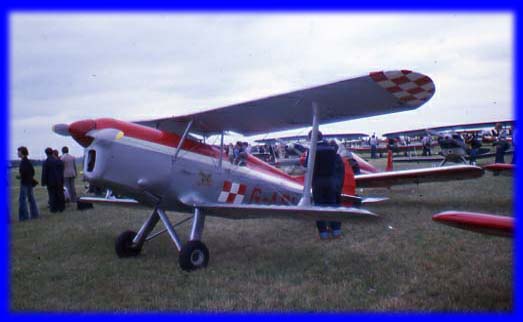
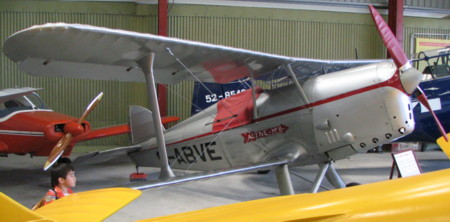 |
The Arrow Active was a sleek, fast one off metal
aerobatic biplane, which first flew in 1932. It was powered by a
120hp De
Havilland Gipsy engine, which gave it a top speed of over 140mph.
Length is 18 feet 10 inches; wing span, 24 feet; maximum weight,
1,325lb, quite a lot for a single seater.
Top picture taken at Cranfield, probably
in the late 1970s. Lower picture taken
at Breighton, June 2006 |
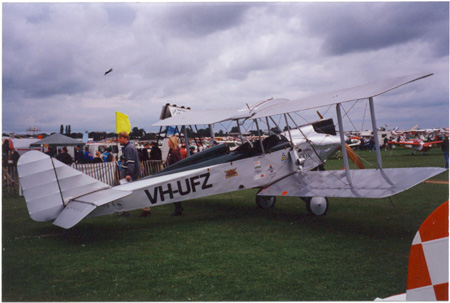 |
The Avro Avian, which first flew in September
1927, was A.V. Roe's rival to the De Havilland Moth. Like the Moth,
it was very successful, with about 410 built. It is a two seater,
powered by a 100hp De Havilland Gipsy 1 engine. This gave it a
cruising speed of 100mph and range of 360 miles. Along with the
Moth, it helped popularise private aviation in the pre-war years. It
is 24 feet 3 inches long, with a span of 28 feet.
This is one of the few survivors, and was at
Cranfield, July 1998 |
|
|
The Avro Triplane was one of the first
designs by British aviation pioneer A.V. Roe. First flown in 1909,
it had a top speed of 40mph on a 35hp Green engine - decent
performance for its day! Maximum weight was 650lb, more than it
might seem, but most of that is engine, pilot and fuel! It is a
single seater and, in common with most types of the period, is
controlled in roll by wing warping rather than what we now think of
as `conventional' ailerons. It is also quite a large machine, 30
feet long and with a wing span of 32 feet.
Only nine were built. This one is in fact a
replica, made in the early 1960s for the film `those magnificent men
in their flying machines', and preserved in airworthy condition at
Old Warden. The only significant difference from the original is the
use of an ADC Cirrus engine in place of the original (unobtainable)
Green.
Lower photograph by Ivy |
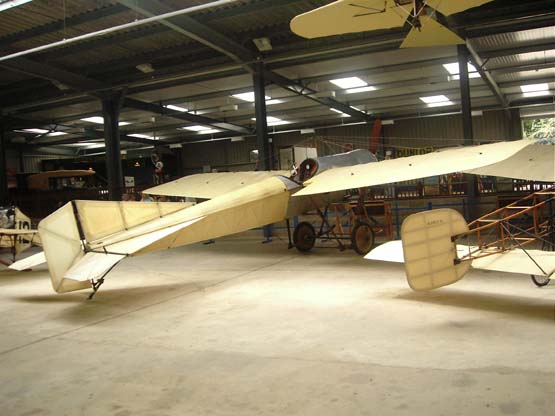 |
This Blackburn Monoplane, built in 1912, is
the oldest British aeroplane still in flying condition. It was built
by Yorkshire pioneer Robert Blackburn. A single seater, it is
powered by a 50hp Gnome rotary engine, which gave it a top speed of
60mph - much faster than the contemporary triplanes and boxkites. At
26 feet 3 inches long it was also shorter, but with a fairly wide
wing span of 32 feet 1 inch. Grossing at 980lb, it was almost as
heavy as the much larger Bristol Boxkite; this largely reflected the
weight of the engine. It is maintained
with immense care by the Shuttleworth Trust at Old Warden, where
this picture was taken in April 2005. Photograph by Ivy |
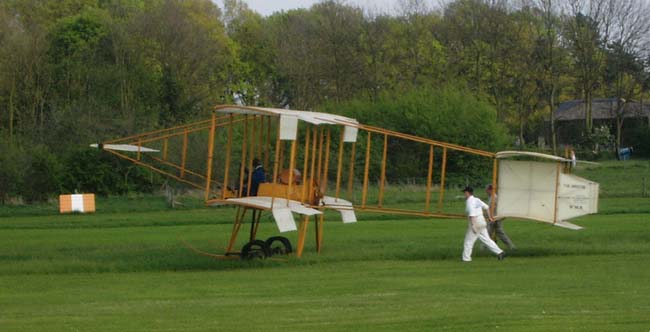 |
The Bristol Boxkite was a primitive two seat
biplane built in Bristol by the British and Colonial Aircraft
Company. (Their machines were always called Bristols, but the
company name was not officially changed to Bristol until the early
1920s.) The original had a 50hp Gnome rotary engine; this replica,
built like the Avro Triplane for `Those Magnificent Men in their
Flying Machines' and pictured at Old Warden in April 2005, has a
Continental O-200. The original first flew in July 1910. Its very
high drag means that it only manages 40mph, though it is quite heavy
for the time at 1,050lb gross weight. With a wing span of 34 feet 6
inches and length (including the foreplane) of 38 feet 6 inches, it
is not small either. Bristol built 78 of these machines, a
respectably large quantity for any machine before the first world
war. |
|
|
The British Aircraft Swallow was essentially
an updated version of the German Klemm Kl 25, but modified to be
fitted with either a 90hp Pobjoy Cataract radial engine or a
Blackburn Cirrus 90hp inline, and other aerodynamic refinements such
as the squared-off tail. It first flew in 1935. In all, 105 were
built, 58 of which had the Cataract engine illustrated in these
photographs. The aircraft had an unrivalled reputation for stability
and safety, which was graphically illustrated by a bizarre incident
to one. The pilot started the engine, as was normal in those days,
by hand-swinging the propeller. Unfortunately he had forgotten to
put the wheel chocks on, so the aircraft, without anybody inside,
trundled across the Kent airfield and happily took off! It flew
absolutely straight until it reached the northern part of East
Anglia where it ran out of fuel and landed in a field, by incredible
luck, more or less unharmed.
It is a two seater, 26 feet 3 inches long,
with a very large wing span of 42 feet 8 inches, and maximum weight
of 1,500lb. The Cataract engine gave it a top speed of 110mph and
range of 400 miles.
The top picture was taken at Old Warden, date
unknown; the lower at Cranfield in July 1988. |
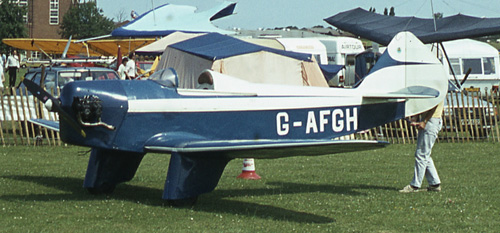 |
The Chilton DW1 was a single seat racing
ultralight aircraft, powered by a iny 30hp Carden Ford engine. On
this trivial power it managed 112mph and had a range of 500 miles -
for an all-up weight of only 640lb. It is a diminutive machine, only
18 feet long and with a 24 foot wing span. It first flew in April
1937. Only seven were built before the War intervened.
This survivor was at
Cranfield, July 1983 |
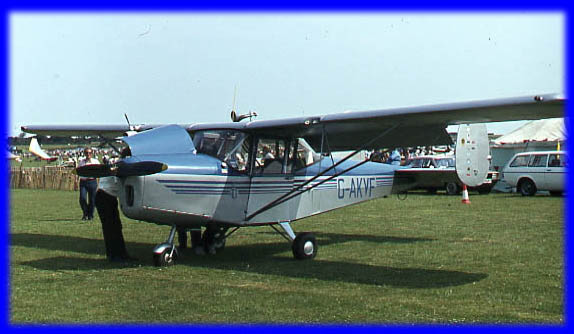
 |
The four seat Chrislea Super Ace was built in
Exeter to the design of Mr R.C. Christophorides. It first flew in
February 1948. It was unusual for a light aircraft of the time in
having a tricycle undercarriage and twin tails, but even stranger
was the initial control system, which dispensed with the traditional
rudder bar and had control in all three axes from a single control
wheel: turning the wheel operated the rudders, lifting or lowering
it operated the elevator, and moving it from side to side operated
the ailerons. Unfortunately this ingenious design was too late to
supersede the `conventional' control layout of all other aircraft of
the time, and was potentially confusing to pilots who had learned on
other types. So later aircraft were built with `normal' controls. 28
were built in all, several of which remain active.
Most were powered by a 145hp De Havilland Gipsy
Major engine, giving cruising speed of 110mph and range of 400
miles. Length is 21 feet, 6 inches; span, 36 feet; and maximum
weight, 2,350lb.
The top picture was taken at Cranfield in July
1983. The lower picture was taken by Ivy at Kemble in July 2005. |
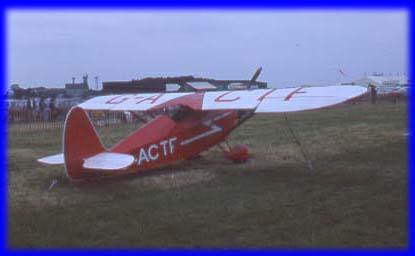 |
The Comper Swift was designed by Flight
Lieutenant Nicholas Comper, and first flew in 1930. It was a single
seat racing aircraft of exceptional performance for the day. Powered
by a Pobjoy Niagara engine of 75hp, it could reach 140mph and had a
range of 380 miles. It must have been almost impossible to see
straight ahead! 42 were built, plus three with DH Gipsy engines.
Length is 17 feet 8 inches, and wing span 24
feet. Maximum weight is 985lb.
This picture was taken by David's father,
probably at Leicester in the mid 1970s. |
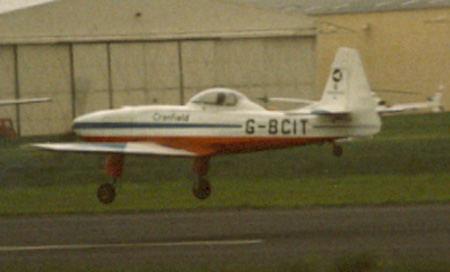 |
This very distant and blurred picture is of
the sole Cranfield A1 taking off from Cranfield in 1998. It was
designed by the Cranfield Institute of Technology, and first flew in
August 1976. It was an attempt to produce a competition aerobatic
machine with superior performance to the then existing machines such
as the Zlin series. It is powered by a 280hp Lycoming IO-540 engine.
At 26 feet 5 inches long, with a wing span of 32 feet 10 inches, and
weighing 2,205lb, its size was dictated by the idea that it would be
more easily seen by the competition judges. Sadly the trend towards
improved performance was leading to smaller machines like the Zlin
50 and CAP series, so the A1, though a worthy machine, was not
pursued.
Cranfield, 1998 |
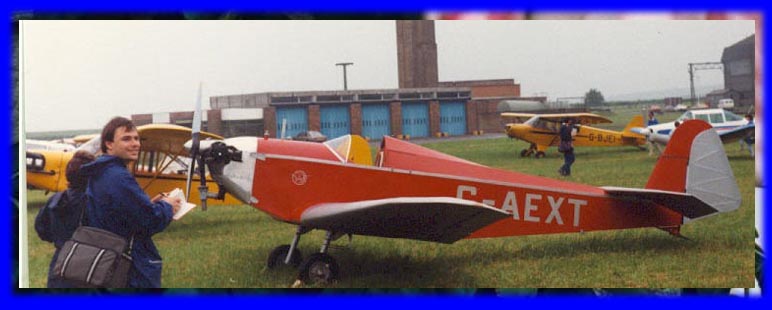 |
The Dart Kitten is a pretty little single
seat light touring aircraft, designed by A.R. Weyl and built by Dart
Aircraft at Dunstable. It first flew in 1936. Only four were made;
it might have become much more popular had the war not intervened.
It had a 36hp JAP J-99 engine, on which meagre power it still
manages to cruise at 85mph for 340 miles. Maximum weight is 835lb.
Length is 21 feet 4 inches and wing span 31 feet 9 inches.
This one was pictured on a gloomy day at
Wroughton in 1988. |
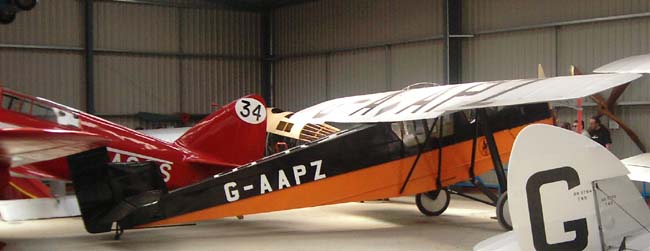 |
The Desoutter 1 involved three pioneering
names in British aviation. It was designed by Frederick Koolhoven,
who started his career as chief designer with Armstrong Whitworth;
made under license by Marcel Desoutter, whose chief engineer made
several modifications. The engineer was G.H. Handasyde, half of the
Martinsyde company which had been a large aircraft pioneer before
and during the first world war. The first Desoutter was made in
1929, followed by 28 Desoutter 1s powered by 115hp Cirrus Hermes
engines, and 13 Desoutter 2s which had more powerful De havilland
Gipsy engines.
It was a three seater, 27 feet long and 36
feet wing span. Top speed was 115mph and range 400 miles. Maximum
weight was 1,900lb.
This one is preserved in flying condition at the Shuttleworth
Collection, Old Warden.
Photograph by Ivy |





|